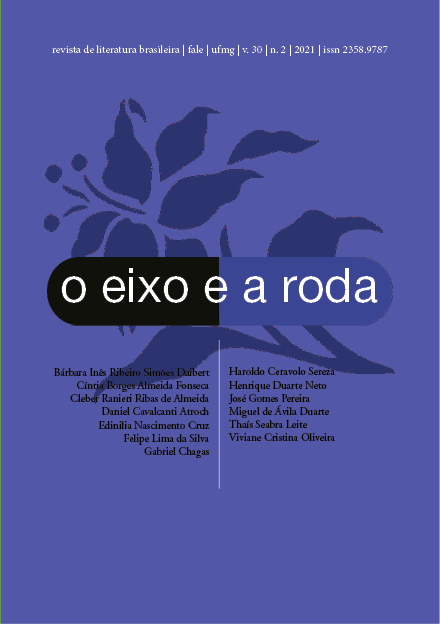“Everything is and is not” between sertão and gerais rosianos
DOI:
https://doi.org/10.17851/2358-9787.30.2.138-153Keywords:
gerais, hinterland, Corpo de baileAbstract
This article seeks to analyze the forms of tensions and distensions in the significant relationship of approximation and detachment between the hinterland and the rosianos gerais, starting from Corpo de baile (1956). In this book, composed by seven narratives, the process of elaboration of the fictional space appears in a diffuse manner, generating specificities that replace the representations of the space that was structured through the impossibility of setting limits between them. We will discuss the hinterland as a mobile system, the central setting of rosiana work, and its deployment in gerais and paths, fundamental categories in the construction of the narrative and in the delimitations of the singularities of the traveling characters. In rosianos texts, the construction of space is placed in a constant process of resignification and appears as places that are paradoxically inside and outside the map. Based on this problematization, we propose to investigate how the manifestations of similarities and differences configure themselves in these polysemic spaces.
Downloads
References
ÁVILA, Myriam. O retrato na rua - memórias e modernidade na cidade planejada. Belo Horizonte: Editora UFMG, 2008.
BOURDIEU, Pierre. O poder simbólico. Tradução: Fernando Tomaz. 4. ed. Rio de Janeiro: Bertrand Brasil, 2001.
BRANDÃO, Luis Alberto.Teorias do espaço literário. São Paulo: Perspectiva, 2013.
CERTEAU, Michel de. A invenção do cotidiano. Artes de fazer. 3. ed. Tradução: Ephraim Ferreira Alves. Rio de Janeiro: Vozes, 1998.
GALVÃO, Walnice Nogueira. Metáforas náuticas. Revista do Instituto de Estudos Brasileiros. São Paulo, n. 41, p. 123-130, 1999. DOI 10.11606/issn.2316-901X.v0i41p123-134
GARBUGLIO, José Carlos. O mundo movente de Guimarães Rosa. São Paulo: Ática, 1972.
LEFEBVRE, Henri. A produção do espaço. Tradução: Doralice Barros Pereira e Sérgio Martins. Belo Horizonte: Editora UFMG, 2006.
LIMA, Deise Dantas. Encenações do Brasil rural em Guimarães Rosa. Niterói: EDUFF, 2001.
NUNES, Benedito. De Sagarana a Grande Sertão: Veredas. In: NUNES, Benedito. Crivo de papel. São Paulo: Ática, 1998.
POULET, Georges. O Espaço proustiano. Tradução: Ana Luiza B. M. Costa. Rio de Janeiro: Imago, 1992.
RONCARI, Luiz.O Brasil de Rosa: mito e história no universo rosiano: o amor e o poder. São Paulo: Editora UNESP, 2004. DOI 10.7476/9788539302819
ROSA, João Guimarães; BIZZARRI, Edoardo. João Guimarães Rosa: correspondência com seu tradutor italiano Edoardo Bizzarri. Rio de Janeiro: Nova Fronteira, 2003.
ROSA, João Guimarães. Corpo de baile. Rio de Janeiro: Nova Fronteira, 2006.
ROSA, João Guimarães. Grande sertão: veredas. 19. ed. Rio de Janeiro: Nova Fronteira, 2001.
SOARES, Claudia Campos. Considerações sobre Corpo de baile. Itinerários, Araraquara, n. 25, p. 39-64, 2007.
SOARES, Claudia Campos. Multiplicidade e unidade: considerações sobre a edição comemorativa dos 50 anos de “Corpo de baile”. Recorte, Três Corações, v. 7, p. 2-12, 2006.
TUAN, Yi-Fu. Topofilia: um estudo da percepção, atitudes e valores do meio ambiente. Tradução: Lívia de Oliveira. São Paulo: Difel, 1983.
WELLS, J. W. Três mil milhas através do Brasil. Tradução: Myriam Ávila. Belo Horizonte: Fundação João Pinheiro; Centro de Estudos Históricos e Culturais, 1995. 2.v.




 Esta obra está licenciada com uma Licença
Esta obra está licenciada com uma Licença 